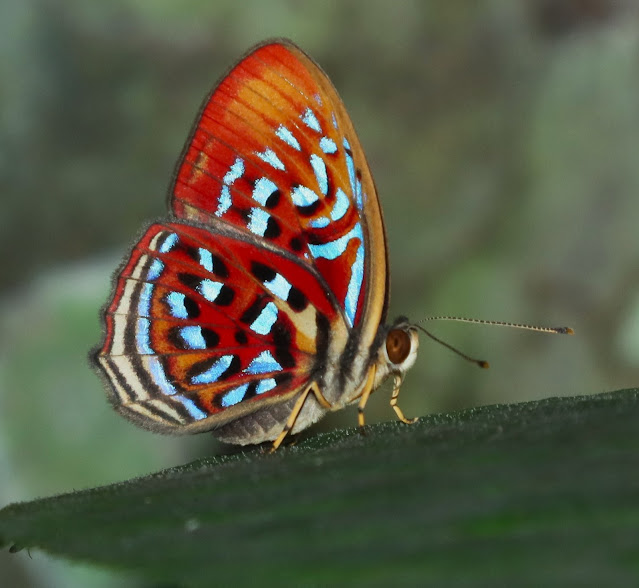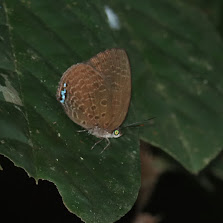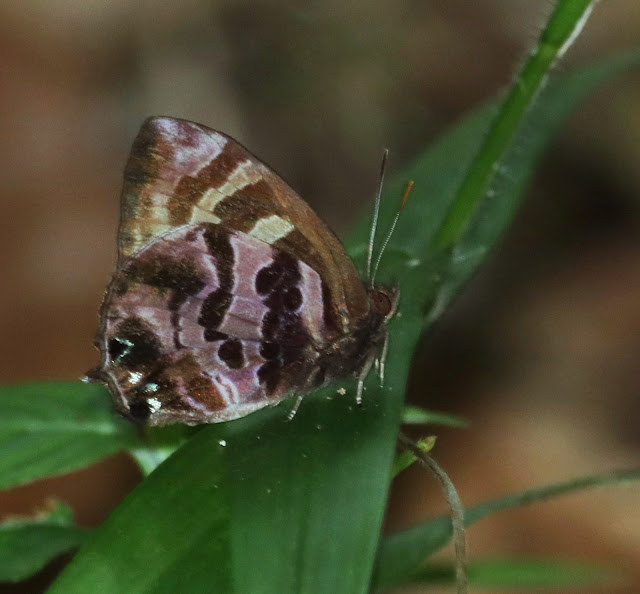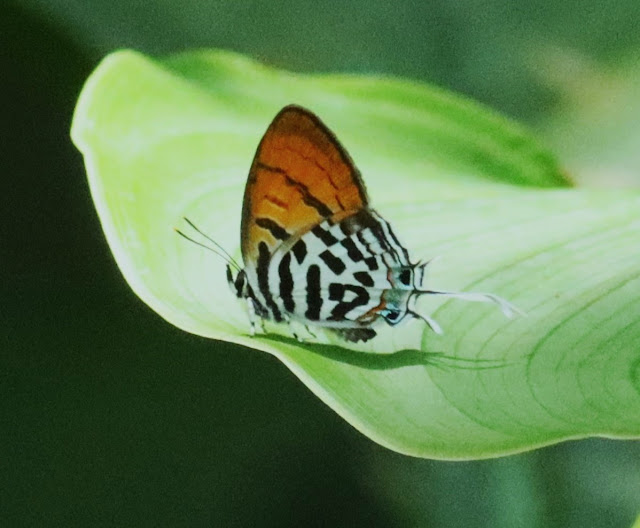I visited two new locations in the month of May and they brought me a few new lifers. Weather in May has been quite good with sunny skies and high humidity. In such weather, butterflies of various species came out and naturally followed by some rare ones. I even managed to get some nice photos as well.
When the sun comes out so as the butties. However, they will usually wait for the sun to be slightly warmer before they expose themselves.
Red Harlequin
(Paralaxita telesia lyclene)
This is an eye level connection. Perfecto !
Pale-haired Palm King
(Amathusia ochraceofusca)
One of those many varieties of Palm Kings in this region.
Bicolor-haired Palm King
(Amathusia friderici holmanhunti f. utana)
Cyclops Bushbrown
(Culapa mnasicles perna)
This is not an ordinary bushbrown baby ! It's rare and my lifer.
Moore's Palm Redeye
(Erionota hiraca)
According to Dr Kirton, this skipper is smaller than Erionota thrax (Banana Skipper) and has the upperside FW apex whitened. In CP5 book, it is named E. acroleuca apicalis which they described as rare. Some also called it White-tipped Palmer.
Purple-streaked Catseye
(Coelites euptychoides humilis)
Together with other species such as Thaumantis, and Zeuxidia, this Catseye frequents the dark alleys of the jungle path.
Silver-spotted Lancer
(Plastinga naga)
First time seeing it after so many years. So it should be an uncommon species.
(Papilio demolion demolion)
I had many nice photos of this Papilio and this is just one of them. Once it starts puddling, you can approach it very near.
Malayan Cruiser
(Vindula erota chersonesia)
This Vindula is larger than the usual Cruiser (Vindula dejone erotella). So happy to see it up close. It is so 'friendly' that you could probably use a macro lens to take its photos.
In a hot and dry season, even rocks can provide the desire minerals. Apparently only males will puddle for salts?
Branded Yeoman
(Algia fasciata)
This is a not so common Yeoman.
Branded Yeoman
(Algia fasciata)
I think this is a localised and seasonal species.
What a beautiful specimen.
Wizard
(Rhinopalpa polynice eudoxia)
Female - slightly larger than the males.
Chocolate Royal
(Remelana jangala travana)
and its not so friendly looking butt.
You can see several species in one go. Here there are probably at least 6 species of different butterflies puddling in harmony.
More puddling group.
The one in the middle is a Catopsilia pomona pomona f . hilaria
Lemon Immigrant
The second one from the right is a Catopsilia pomona pomona f. alcmeone
Lemon Immigrant
The middle one should be a male Lesser Cruiser (Vindula dejone erotella)
Those two are Orange Gulls (Cepora iudith malaya)
Quite often seen nowadays.
Redspot Sawtooth
(Prioneris philonome themana)
This one is much larger than the above Cepora (Orange Gulls).
Orange Albatross (Appias nero figulina) and a Common Bluebottle (Graphium sarpedon luctatius)
Now, how about the one below here?
Another excellent specimen
Fivebar Swordtail
(Graphium antiphates itamputi)
Here is a recent surprise find. A prince came to my area.
Common Nawab
(Polyura athamas)
It can fly quite fast actually when disturbed.
These are two different individuals. Male n female perhaps?
Straight Snow Flat
(Tagiades parra naxos)
(Matapa aria)
Here is something different from the book.
Experts have identified the above as a Common Tit (Hypolycaena erylus teatus)
Did the extreme climate just changed / diluted its colors?
Left = Zema Banded Ace (Halpe zema zamba)
Right = Dark Banded Ace (Halpe ormenes vilasina)
Here is another Ace !
Pale Marked Ace
(Halpe hauxwelli)
A comparison of some common Silverlines
HERE COMES MY FAVOURITE PART OF EVERY POSTS
IDENTIFICATION OF ARHOPALAs / OAKBLUEs
White-dot Oakblue(Arhopala democritus lycaenaria)
Green-suffused Oakblue
(Arhopala trogon)
It has a beautiful shinning green upperside.
(Flos fulgida singhapura)
Lastly I end this month's post with a one in a life time photo.
The above photo should support the theory that some Lepidopteras do help in the pollination process.
HAVE A GREAT TIME WITH YOUR BUTTERFLY FRIENDS !!





































































































